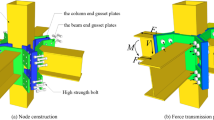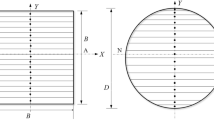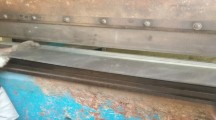Abstract
Mechanics-based models are developed for the moment, the curvature and the chord rotation at yielding of circular concrete columns or piers, their secant stiffness to the yield point and the ultimate curvature and flexure-controlled ultimate chord rotation in cyclic loading. The strain criteria for yielding or ultimate are calibrated on the basis of over four hundred test results. Besides the model for the secant-to-yield-point stiffness which is in terms of the yield moment and chord rotation, an empirical one, independent of the vertical reinforcement, is fitted to the data. The ultimate chord rotation is obtained from a plastic hinge model employing a plastic hinge length, the yield and the ultimate curvatures of the end section and the fixed-end rotation due to slippage of bars from their anchorage zone beyond the column length. All models are extended to columns the vertical bars of which are lap-spliced within the plastic hinge and to columns with FRP wrapping and continuous or lap-spliced vertical bars. The comprehensive portfolio of expressions proposed for the deformation properties of circular columns is fully consistent across the various situations of continuous or lap-spliced bars, with or without FRP wrapping, and with models developed by the authors from much larger databases of rectangular columns in similar situations; the aspects specific to circular sections are limited to the mechanics-based section analysis for moment and curvature, a purely empirical coefficient for the secant-to-yield-point stiffness and the empirical plastic hinge length.










Similar content being viewed by others
References
Biskinis DE, Fardis MN (2009) Upgrading of resistance and cyclic deformation capacity of deficient concrete columns. In: Ilki et al (eds) Seismic risk assessment and retrofitting, with special emphasis on existing low rise structures. Springer, Dordrecht, pp 307–328
Biskinis DE, Fardis MN (2010a) Deformations at flexural yielding of members with continuous or lap-spliced bars. Struct Concr 11(3):127–138
Biskinis DE, Fardis MN (2010b) Flexure-controlled ultimate deformations of members with continuous or lap-spliced bars. Struct Concr 11(2):93–108
CEN (2004) European standard EN1992-1-1:2004 Eurocode 2: design of concrete structures, part 1–1: general rules and rules for buildings. Comité Européen de Normalisation, Brussels
CEN (2005) European standard EN 1998-2:2005 Eurocode 8: design of structures for earthquake resistance. Part 2: Bridges. Comité Européen de Normalisation, Brussels
Fardis MN (2013) Performance- and displacement-based seismic design and assessment of concrete structures in the Model Code 2010. Struct Concr 11(3). doi:10.1002/suco.201300001
FIB (2012) Model code 2010—final draft. fib Bull. 65 and 66. Federation Internationale du Beton, Lausanne
Lam L, Teng JG (2003) Design-oriented stress-strain model for FRP-confined concrete. Constr Build Mater 17(6 &7):471–489
Mander JB, Priestley MJN, Park R (1988) Theoretical stress-strain model for confined concrete. ASCE J Struct Eng 114(8):1804–1826
Paulay T, Priestley MJN (1992) Seismic design of reinforced concrete and masonry buildings. Wiley, New York
Priestley MJN, Seible F, Calvi GM (1996) Seismic design and retrofit of bridges. Wiley, New York
Acknowledgments
The research leading to these results has received funding from the European Community’s 7th Framework Program [FP7/2007-2013] under grant agreement \(\text{ n }^{\circ }\) 204697 (ACES).
Author information
Authors and Affiliations
Corresponding author
Rights and permissions
About this article
Cite this article
Biskinis, D., Fardis, M.N. Stiffness and cyclic deformation capacity of circular RC columns with or without lap-splices and FRP wrapping. Bull Earthquake Eng 11, 1447–1466 (2013). https://doi.org/10.1007/s10518-013-9442-7
Received:
Accepted:
Published:
Issue Date:
DOI: https://doi.org/10.1007/s10518-013-9442-7




